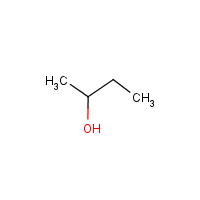sec-Butyl alcohol
Agent Name
sec-Butyl alcohol
Alternative Name
sec-Butanol
CAS Number
78-92-2
Formula
C4-H10-O
Major Category
Solvents

Synonyms
sec-Butanol; 1-Methyl propanol; 1-Methyl-1-propanol; 1-Methylpropyl alcohol; 2-Butanol (natural); 2-Butyl alcohol; 2-Hydroxybutane; Alcool butylique secondaire [French]; Butan-2-ol; Butanol secondaire [French]; Butyl alcohol, sec-; Butylene hydrate; CCS 301; Ethyl methyl carbinol; Ethylmethyl carbinol; Methyl ethyl carbinol; Methylethyl carbinol; Methylethylcarbinol; s-Butanol; s-Butyl alcohol; sec-Butanol; [ChemIDplus] UN1993
Category
Alcohols (<C12)
Description
Colorless liquid with a strong, pleasant odor; [NIOSH]
Sources/Uses
Used as a solvent, paint remover, and cleaner; also used to manufacture other organic compounds; [ACGIH]
Comments
A skin, eye, and respiratory tract irritant; Inhalation of high concentrations can cause CNS depression; [ICSC]
Biomedical References
Exposure Assessment
Skin Designation (ACGIH)
Insufficient data
TLV (ACGIH)
100 ppm
PEL (OSHA)
150 ppm
IDLH (NIOSH)
2000 ppm
Excerpts from Documentation for IDLHs
Basis for original (SCP) IDLH: The chosen IDLH is based on the statements by Patty [1963] that 10,670 ppm for 225 minutes and 16,000 ppm for 160 minutes were fatal for mice [Weese 1928]. According to Patty [1963], at 20,000 ppm it took 12 to 20 minutes to produce prostration in mice and 40 minutes to produce narcosis; no deaths occurred [Starrek 1938]. The chosen IDLH is probably conservative.
Vapor Pressure
18.3 mm Hg
Odor Threshold Low
0.12 ppm
Odor Threshold High
13.8 ppm
Lethal Concentration
LCLo (rat) = 16,000 ppm/4H
Explanatory Notes
Detection odor threshold from AIHA (mean = 3.2 ppm); Flash point = 75 deg F; VP from HSDB;
NFPA
may ignite at ambient temp
Adverse Effects
Neurotoxin
Acute solvent syndrome
Diseases, Processes, and Activities Linked to This Agent
Diseases
Occupational diseases associated with exposure to this agent:
Processes
Industrial Processes with risk of exposure: